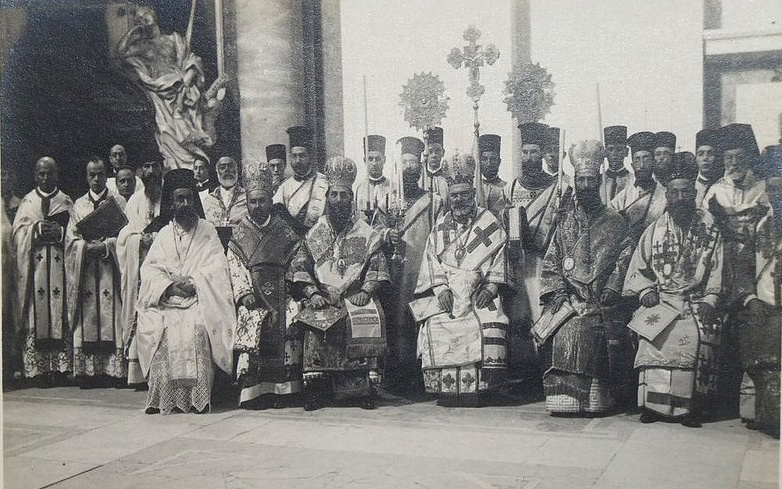
Greek Catholic clergy in Italy, early 1900s
HOME
Who is ‘Orthodox’?
Different kinds of Eastern and similar churches
From 2001; updated in 2009
I posted this on Usenet to answer this question, writing originally for a largely Orthodox readership. I hope this overview is fair.
The broadest working definition of ‘Orthodox’ is: those episcopal (governed by bishops who claim apostolic succession), sacramental, liturgical Churches that use the Byzantine liturgical rite, canon law, etc., hold to the seven ecumenical councils from Nicæa in the 300s to Nicæa II in 787 and are not now in communion with the Pope of Rome, after a gradual estrangement in the early Middle Ages. Missing from this definition are the small experimental Western Rite churches some groups have, mostly made up of former Episcopalians in the US.
The stricter, catechetical definition of ‘Orthodox’ would narrow this to the Churches recognized by all the other Orthodox Churches as independent (self-headed or autocephalous, usually headed by a patriarch) and with whom they are in communion. This communion of Churches and their dependent (mission) churches makes up the Orthodox Church.
There are splinter groups that fall outside these strict parameters, like, until 2007, the Russian Orthodox Church Outside of Russia, an exile group formed after the Russian Revolution, the Russian Old Believer churches formed centuries ago starting in the 1600s and various Greek and other groups founded to protest the use of the Gregorian calendar by their countries’ Churches, but few people say they are not Orthodox. Before 2007 ROCOR was in the Orthodox communion thanks to its tie to the Church of Serbia; now it is back in the Church of Russia. The groups not in communion with any Orthodox church are, technically, non-Orthodox. But hardline true-believer and nationalist schisms again are seen as still ‘part of the family’ and are received back into communion economically, that is, without repeating baptism, chrismation or ordination. (The fun Greek theological term for these is parasynagogues.)
Orthodox-like groups outside Orthodoxy fall into three categories: 1) Greek/Byzantine Catholics (including the Ukrainian Catholics and the Melkites), 2) the Lesser Eastern Churches and 3) vagantes.
The first once were Orthodox but partly on their own and partly due to Roman Catholic missionaries went under the Pope starting in the 1500s. These Churches once were convert-making tools used by Roman Catholics to hurt the Orthodox but that policy, called ‘Uniatism’, has been discarded. (The goal is corporate reunion not individual conversions but of course the latter, rare, are accepted, quietly.) There is some confusion among Orthodox and Roman Catholics alike about the status of the Greek Catholics and what exactly they believe in. Are they exactly like Orthodox only in communion with the Pope? A few Greek Catholics, mostly converts from Western churches and mostly online, hold this and try to make it so. Are they just like Roman Rite Catholics but with a different rite and an ethnic flavour? Do the postschism Roman definitions of dogma apply to them? Today most Greek Catholics, who are ethnic born members, say yes to both. Are they full Churches like the Orthodox or just appendages of the Roman Catholic Church? Again you’ll get different answers depending on who you ask. Rome says they’re supposed to be just like the Orthodox externally but believe all postschism Roman definitions, but in practice they’ve often self-latinized. In practice the Orthodox often have treated them as an estranged part of the family like their true-believer and nationalist splits, and received them back through simple professions of faith. (As often happened in America around 1900 after they were treated badly by the local Roman Rite clergy.)
The Lesser Eastern Churches are of several different non-Byzantine but Eastern rites and form two groups, the Oriental communion (Copts, Ethiopians, Armenians and Syrians including Indians) and the Assyrian churches (commonly called Nestorian, the native Christianity of what is now Iraq). The break with the Assyrians was after the third ecumenical council at Ephesus; with the Oriental communion after the fourth at Chalcedon. Both were long thought to be heretics denying the truth about the natures of Christ: Monophysitism in the case of the Orientals, denying Christ’s human nature; Nestorianism in that of the Assyrians, separating his divine and human natures. The Armenian and Assyrian rites are older than the use of icons, and the Assyrian liturgy is the oldest still used (the Roman Rite is the second) with form of Jesus’ vernacular as its liturgical language. Polity and church life in general are as in Orthodoxy and these groups are often lumped together with it. As the understanding today is that the splits were misunderstandings and these churches are not actually heretical that may well be true soon. (There are churches of these rites under Rome too.)
The last group is the ragtag bunch of tiny churches that exist largely on paper and on the Web (few real members and practically no generational members) and on the fringes of the Anglican and Roman Catholic churches whence its people come. They often call themselves ‘Old Catholics’ (not to be confused with the actual Old Catholic sect in Germany and Holland) but recently, adopting some Eastern trappings piecemeal and liking the decentralized, nonpapal ecclesiology of the real Orthodox, have taken to passing themselves off as Orthodox. You often will find a weird mix of liberalism with a liking for traditional ritual. And on close inspection, underneath the vestments and the fancy titles they affect, you find the real reasons why they broke with their original church, like active homosexuality, wanting to ordain women, etc. They make much of their ‘lines’ of apostolic succession, sometimes false, and something real Orthodox, who emphasize the communion of the Church more than lineage, don’t do.

Greek Catholic clergy in Italy, early 1900s
HOME